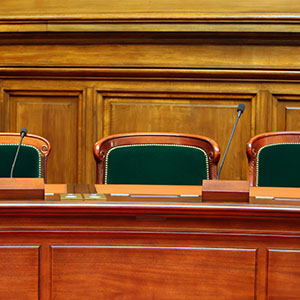This is a consolidated securities class action against Brambles Ltd (Brambles). The applicants allege that Brambles engaged in misleading or deceptive conduct and contravened its continuous disclosure obligations by releasing, and subsequently reaffirming, certain guidance to the Australian Securities Exchange in financial year 2017.
In this decision, Murphy J dismissed an interlocutory application filed by Brambles seeking an order pursuant to s 47A(1) of the Federal Court of Australia Act 1976 (Cth) (FCAA) for two of its lay witnesses (Mr Martin and Ms Nador) to be permitted to give evidence at the trial of the proceeding via video link.
His Honour held that the video link arrangements proposed by Brambles met the technical requirements required by s 47C of the FCAA. As such, the discretion under s 47A(1) of the FCAA to allow its witnesses to give evidence remotely was available for exercise.
After reviewing the relevant authorities, his Honour observed that courts have considered a variety of factors in exercising the discretion to permit video link evidence, including the employment commitments of an overseas witness; whether the credibility of the witness is in issue; whether the witness’ evidence will be “centrally important” to the case; and whether the use of video link may frustrate or delay the management of documents in cross- examination. However, his Honour said that those factors are neither exhaustive nor prescriptive and the discretion under s 47A(1) of the FCAA is a broad one. Ultimately, however, it is for the party seeking that its witnesses be permitted to give evidence via video link to establish the reason for it, having regard to the specific facts and the overriding consideration of ensuring that justice is done as between the parties to the proceeding.
His Honour was not persuaded by Brambles’ reliance on several decisions in which courts had permitted evidence via video link during the COVID-19 pandemic. His Honour said (at [39]-[41]):
I have no difficulty in accepting that in many cases it will be suitable for evidence to be received via video link, and it is plain that during the height of the COVID-19 pandemic courts were more inclined to grant such applications. It is unsurprising that such applications were more readily granted when one considers the context in which that occurred – the strictest mandatory public health measures ever imposed in Australia, with Australia’s international and state borders being closed and travel and in-person gatherings being banned or severely restricted. During the height of the pandemic, judges of this and other courts took a more pragmatic approach to the exercise of the discretion, faced as they were with the undesirable alternative of numerous adjournments, extensive backlogs that might arise from such adjournments, and uncertainty as to the duration of the required adjournment.
I do not seek to downplay the significance of the various judicial observations expressing satisfaction, even enthusiasm, in relation to the efficacy of cross-examination via video link, including where issues of credit are involved, but in my opinion they should be understood in the context in which they were made…
Further, as Lee J noted in Palmer (at [44]), “a number of the particularly favourable judicial references to remote hearings in complex cases were made in 2020, at an early stage of the ‘unforeseen mass-pilot of remote hearings’” brought about through the pandemic. His Honour said that the “accumulated experience” of judges and “subsequent reflection” had caused his views and the views of some other judges to change over time.
In any event, his Honour said that the views of other judges with respect to the efficacy of cross-examination via video link were of little relevance, as it would be his task to assess the reliability of Mr Martin’s and Ms Nador’s evidence at trial and decide whether effective cross- examination of them may be hindered if they were to give evidence via video link.
Ultimately, his Honour refused Brambles’ application to hear Mr Martin’s and Ms Nador’s evidence via video link. The key reasons for his Honour’s decision included the following.
- First, Mr Martin’s and Ms Nador’s evidence was contentious and significant to the dispute in the proceeding, and their cross-examination was likely to be lengthy, and involve consideration of numerous documents and issues of credit.
- Second, allowing the witnesses to give evidence via video link would have advantaged Brambles and disadvantaged the applicants. His Honour observed that cross-examination via video link in large complex cases involving numerous documents is more difficult and less effective than cross-examination in court in person. Further, giving evidence via video link confers an advantage on the party calling the witness, because it “permits the witness to give evidence from the comfort of his or her own home or office, freed from the solemnity of the occasion which being in court carries with it” (at [51]).
- Third, his Honour was concerned that he may have been hindered in assessing the reliability of the witnesses’ evidence via video link, particularly given the complexity of the case, the number of documents involved, and issues of credit.
- Fourth, the prejudice Brambles was likely to suffer if the application was refused resulted from steps that it, or its solicitors Allens, had failed to take, and certainly did not arise from anything the applicants had done. With respect to Mr Martin, his Honour accepted that:
Mr Martin had refused to travel to Australia to give evidence in person, and, therefore, the choice was between him giving evidence via video link or not giving evidence at all; (ii) the loss of Mr Martin’s evidence would prejudice Brambles’ defence, which he treated as a “powerful” consideration; (iii) Mr Martin was an overseas resident and no longer employed by Brambles, and Brambles could therefore not compel him to give evidence in person; and (iv) Mr Martin was involved in a confidential transaction in his current role as CEO of a USA-based supply-chain logistics company, which would overlap and conflict with him travelling to Australia to give evidence in person. However, his Honour observed that the trial date had been set since August 2021 and Mr Martin had sworn two affidavits for Brambles in the proceeding, the first nine months before trial in November 2021. Notwithstanding this, Brambles’ evidence showed that Allens did not take steps to be satisfied as to the capacity and willingness of its overseas-based witnesses to travel to Australia to give evidence in person at the trial until about seven weeks before the commencement of the trial. His Honour said this was “much too late” and the arrangements for Brambles’ witnesses should have been “locked in” much earlier. His Honour also observed that the application to hear Mr Martin’s and Ms Nador’s evidence via video link was made very late; and was heard just three business days before the commencement of the five week trial.
The same criticisms applied to Brambles’ application for Ms Nador’s evidence to be heard via video link. In addition, his Honour observed that Ms Nador was still employed by Brambles; the impediment to her travelling to Australia to give evidence in person was an internal conference that Brambles itself had scheduled to conflict with the trial; and there was no evidence before the Court that she had in fact refused to travel to Australia to give evidence in person.
As it would turn out, Brambles did not suffer any prejudice as a result of his Honour’s decision to refuse its witnesses to give evidence via video link. His Honour noted (at [6]):
Then, surprisingly, on the first day of trial Brambles informed the Court that Mr Martin’s and Ms Nador’s position had changed. Both would now travel to Australia to give evidence in person. I cannot know, but it appears that their unwillingness to give evidence in person was, in reality, based on inconvenience rather than inability.
Southernwood v Brambles Ltd (No 2) [2022] FCA 973
Federal Court of Australia, Murphy J,
5 August 2022
First Applicant’s Solicitors: Slater & Gordon
Second Applicants’ Solicitors: Maurice Blackburn
Respondent’s Solicitors: Allens
First Applicant’s Funder: Omni Bridgeway Ltd
Second Applicants’ Funder: Harbour
< Go back to Class Actions Landscape Australia
We're here to help
Contact us today
Learn more about our class actions work
We're Australia's leading class action practice, and we've obtained more than $4.3 billion in settlements for our clients.
Easy ways to get in touch
We are here to help. Give us a call, request a call back or use our free claim check tool to get in touch with our friendly legal team. With local knowledge and a national network of experts, we have the experience you can count on.
Office locations
We’re here to help. Get in touch with your local office.
Select your state below
- VIC
- QLD
- NSW
- WA
- ACT
- SA
- TAS
- NT
We have lawyers who specialise in a range of legal claims who travel to Australian Capital Territory. If you need a lawyer in Canberra or elsewhere in Australian Capital Territory, please call us on 1800 675 346.
We have lawyers who specialise in a range of legal claims who travel to Tasmania. If you need a lawyer in Hobart, Launceston or elsewhere in Tasmania, please call us on 1800 675 346.


